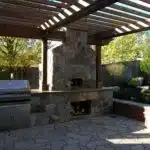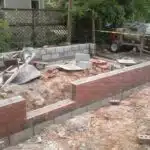Creating a backyard playground can be an exciting and rewarding DIY project for families who enjoy spending time outdoors. A well-designed backyard playground provides a safe environment for children to play, exercise, and learn while also enhancing the overall aesthetics of the outdoor living space. However, building a DIY backyard playground requires careful planning and execution to ensure safety and durability.
In this article, we will explore how to build a DIY backyard playground that is not only fun but also safe for children. We will cover important factors such as selecting an appropriate location, choosing the right materials, designing the layout, and installing essential features such as swings, slides, and climbing structures. Whether you are a seasoned DIY enthusiast or just starting out with outdoor projects, this guide will provide you with valuable insights and practical tips on how to create a beautiful and functional backyard playground that your family can enjoy for years to come.
Assessing Your Space And Needs
Did you know that according to the American Academy of Pediatrics, over 200,000 children are injured on playgrounds each year? This statistic highlights the importance of building a safe and secure backyard playground for your kids. Before starting any construction, it is crucial to assess your space and needs.
Begin by assessing your budget. Determine how much you can afford to spend on materials and equipment before starting your project. Keep in mind that the cost will depend on various factors, including the size of your yard, the type of equipment you want to install and whether you plan to hire a professional contractor or go the DIY route.
Next, determine the age range of children who will be using the playground. This information will help you decide what type of play equipment is appropriate for your needs. Younger children require smaller equipment with less height and fewer challenging features than older kids who need more complex structures with higher levels of difficulty. By knowing your age range, you can ensure that all children have fun while staying safe.
Assessing your space and needs is an essential first step in building a DIY backyard playground. Once you’ve determined your budget and age range requirements, it’s time to move on to choosing the right location for your playground where safety should remain paramount.
Choosing The Right Location For Your Playground
When it comes to building a DIY backyard playground, choosing the right location is crucial. The first step is to consider your landscaping options. A flat and level area is ideal for a playground, but if your yard has a slope, you may need to consider grading the area or building retaining walls. Trees can provide shade and natural elements for play, but make sure they are not too close to the play equipment or have low-hanging branches that could be hazardous.
Environmental factors should also be taken into consideration when selecting the location for your backyard playground. Take note of the amount of sunlight and wind exposure in the area throughout different times of day as well as how much rainfall and drainage occurs in the area. These factors can affect both safety and maintenance requirements for your playground equipment.
To help you choose the best location, here are three key factors to keep in mind:
- Accessibility: Make sure that children can easily access the play area from your home without having to navigate through any dangerous obstacles.
- Visibility: Choose an open area with good sightlines so that adults can supervise children at all times.
- Proximity to other structures: Be mindful of nearby structures such as fences, sheds, or pools that could pose safety hazards or limit space for play.
Considering these important factors will help ensure that you choose a location that provides a safe and enjoyable environment for children to play in your backyard. In order to further ensure safety, it’s important to follow specific regulations and guidelines which we will discuss in our next section on safety considerations and regulations.
Safety Considerations And Regulations
After selecting the right location for your backyard playground, it’s important to consider safety considerations and regulations. Building a playground can be a fun project, but it’s not worth risking injuries or violating certification requirements. Before you start constructing, make sure you assess the risks and take necessary precautions.
Certification requirements vary depending on where you live and the type of playground you’re building. In the US, the Consumer Product Safety Commission (CPSC) has guidelines for public playgrounds that serve as a great starting point for DIY playground builders. These guidelines cover everything from equipment spacing to surface materials to ensure that children can play safely. It’s also important to check with your local government about any additional regulations or permits required in your area.
Before starting construction, conduct a thorough risk assessment of your backyard space. Identify potential hazards such as sharp objects, unstable terrain or overhead obstructions like trees and power lines. Assess how these hazards may impact children playing on the equipment and come up with solutions to eliminate them or minimize their risks. By taking proper precautions and following certification requirements, you can ensure that your DIY backyard playground is both fun and safe for children.
Table:
| Risk Assessment Checklist | Hazards | Solutions |
|---|---|---|
| Equipment safety | Loose bolts, sharp edges | Tighten bolts regularly; sand down edges |
| Surface material | Hard surfaces like concrete | Use soft materials like rubber mats or wood chips |
| Overhead obstructions | Trees, power lines | Trim trees back; move equipment away from power lines |
| Age-appropriate design | Equipment too challenging for age group | Consult age guidelines; adjust equipment as needed |
Transition: Once you’ve completed a thorough risk assessment and made necessary adjustments to ensure safety, it’s time to move onto selecting appropriate playground equipment.
Selecting Playground Equipment
When it comes to selecting playground equipment for your backyard, there are a few factors to consider. One of the most important is budget considerations. Playground equipment can vary greatly in price depending on the size and complexity of the structure. It’s important to set a budget before you begin shopping so that you have a clear idea of what you can afford.
Another factor to consider when selecting playground equipment is age appropriateness. Different pieces of equipment will be appropriate for different age ranges, so it’s important to choose equipment that is suitable for the age group of children who will be using it. For example, swings and slides are great for younger kids, while older children may prefer more challenging structures like climbing walls or rope courses.
When selecting playground equipment, it’s also important to keep in mind durability. The equipment should be able to withstand regular use and exposure to the elements without deteriorating or becoming unsafe. Look for materials that are sturdy and weather-resistant, such as metal or plastic. Additionally, make sure that all hardware and fasteners are secure and won’t come loose over time.
Moving on from selecting playground equipment, the next step is choosing material options and considering durability. There are several different materials available for backyard playground construction including wood, plastic composite lumber, metal and concrete. Each has its own set of advantages and disadvantages when it comes to durability and maintenance requirements.
Material Options And Durability
Selecting the right equipment for your backyard playground is just one piece of the puzzle. The materials you use also play a critical role in ensuring the durability and safety of your playground. You want to choose materials that can withstand harsh weather conditions and are safe for children to play on.
Recycled materials are a great option for those who want to build an eco-friendly playground. Not only do they help reduce waste, but they are also durable and weather-resistant. Recycled plastic lumber, for example, is an excellent choice as it is resistant to rot, insects, and UV radiation. Another option is rubber mulch made from recycled tires, which provides a cushioned surface for falls and is long-lasting.
When choosing materials for your DIY backyard playground, it’s essential to consider their resistance to weather conditions. Harsh sunlight, rain, snow, and extreme temperatures can all take a toll on the structure over time. Wood treated with preservatives or composite materials like PVC may be more resistant to these elements than untreated wood. In addition, stainless steel hardware can prevent rusting and ensure the longevity of your playground.
To ensure that your backyard playground lasts for years to come, it’s crucial to choose durable and weather-resistant materials such as recycled plastic lumber or rubber mulch made from recycled tires. Additionally, using treated wood or composite materials can help protect against harsh weather conditions like extreme temperatures and heavy rainfall. By selecting high-quality materials upfront, you’ll save yourself time and money on repairs down the road while keeping your children safe during playtime.
As you move forward in designing a layout and planning your build, keep these material options in mind so that you can create a fun yet safe environment for your children to play in.
Designing A Layout And Planning Your Build
1.When designing a backyard playground, the size of the area must be determined in order to properly plan the build. 2.A variety of materials can be used to construct the backyard playground, including wood, metal and plastic, and each material has its own advantages and disadvantages. 3.It is important to create a budget for the build and to research the cost of the materials to ensure that the build can be completed within a desired price range. 4.When choosing materials, factors such as durability, aesthetics, safety and cost must be considered. 5.The size of the playground should also be taken into consideration, as certain materials may not be suitable for larger builds. 6.By planning ahead and investing in appropriate materials, a diy backyard playground build can be completed efficiently and cost-effectively.
Determining Size
When designing a layout and planning your build for a DIY backyard playground, determining the appropriate size is crucial. As an expert in this field, I suggest starting by maximizing the available space to ensure your children have room to play and explore. Take into account any potential obstacles such as trees or uneven terrain that could impact the overall size of your play area.
Budget considerations are also important when determining the size of your DIY backyard playground. It’s easy to get carried away with elaborate designs and features, but it’s essential to stay within your budget to avoid overspending. By carefully considering the size of your play area, you can plan accordingly and use materials more efficiently.
Ultimately, when deciding on the appropriate size for your DIY backyard playground, think about what will work best for you and your family. Consider factors such as age range, number of children using the play area, and specific activities they enjoy. By taking these elements into consideration along with maximizing space and sticking to a budget, you can create a safe and enjoyable outdoor play area for your children to enjoy for years to come.
Choosing Materials
When it comes to designing a layout and planning your build for a DIY backyard playground, choosing the right materials is just as important as determining the appropriate size. As an expert in this field, I suggest considering eco-friendly options such as recycled plastic or sustainably sourced wood. Not only are these materials better for the environment, but they can also provide a durable and long-lasting solution for your play area.
In addition to eco-friendly options, cost-effective alternatives should also be considered when selecting materials for your DIY backyard playground. For example, using pea gravel instead of expensive rubber mulch can save you money without sacrificing safety. Additionally, repurposing items such as tires or pallets can add a unique touch while keeping costs low.
Ultimately, when choosing materials for your DIY backyard playground, it’s important to consider both environmental impact and budget constraints. By exploring eco-friendly and cost-effective alternatives, you can create a safe and sustainable outdoor play area that will provide enjoyment for years to come.
Creating A Budget
When it comes to designing a DIY backyard playground, one of the most important aspects to consider is your budget. While you want to create a fun and safe play area for your children or other family members, you also don’t want to break the bank. Therefore, it’s essential to carefully plan and research cost-saving techniques and materials.
One effective way to create a budget-friendly playground is by using materials that are both durable and affordable. For instance, pressure-treated lumber is a popular choice because it’s relatively inexpensive and can withstand harsh weather conditions. Similarly, pea gravel is an affordable alternative to pricier rubber mulch that still provides ample cushioning for falls.
Another consideration when creating a budget for your DIY backyard playground is repurposing items from around your home or community. For example, old tires can be transformed into swings or obstacle course components with minimal effort and cost. Additionally, repurposing wooden pallets can provide an inexpensive option for building structures like forts or climbing walls.
In conclusion, creating a fun and safe DIY backyard playground doesn’t have to be expensive. By utilizing budget-friendly materials and cost-saving techniques like repurposing items, you can design an enjoyable outdoor space without breaking the bank. With careful planning and research, you can create an affordable play area that provides hours of entertainment for your family while staying within your budget constraints.
Preparing The Site And Laying The Foundation
As you prepare to build your DIY backyard playground, the first step is to prepare the site. Excavation is a crucial part of this process and requires some tips and tricks to ensure that the area is clear of debris, rocks, and other obstacles. You can use a shovel or an excavator to dig out the area, but it’s important to make sure that you’re not digging too deep or too shallow.
Once the excavation is complete, it’s time to focus on leveling the ground. This is where you’ll need some leveling techniques to ensure that your playground surface is even and safe for children to play on. You can use a laser level or a water level to check for any high or low spots in the ground. If you find any uneven areas, you can use soil or sand to fill them in and create a smooth surface.
By following these excavation tips and leveling techniques, you’ll be able to lay a solid foundation for your DIY backyard playground. With a leveled surface that’s free of debris and obstacles, you’ll be ready to move onto building supports and frames for your playset.
Building Supports And Frames
After the foundation has been laid, it’s time to move on to building supports and frames. The first step is to determine the design of your playground. Customizing designs can be done by choosing different shapes or sizes for your supports and frames. It’s important to consider the size of your backyard, how many children will be using the playground, and what types of activities they’ll be doing.
Once you have a design in mind, it’s time to start building. Reinforcing structures is crucial for safety purposes. This means using sturdy materials such as pressure-treated lumber or steel posts, and securing them with concrete footings. It’s also important to ensure that all screws and bolts are tight and secure before moving on to the next step.
As you build the supports and frames, keep in mind that they will need to accommodate swings and slides. Take into consideration their weight limits, heights, and clearances when placing them on the structure. Once everything is securely in place, it’s time to move on to installing swings and slides.
Installing Swings And Slides
Now that you have leveled the ground and constructed the main frame, it is time to move on to the fun part of building a DIY backyard playground – installing swings and slides! With a few tips and tricks, you can easily transform your backyard into a kid’s paradise.
DIY swing installation requires careful consideration of various factors such as choosing the right type of swing, ensuring proper height, and using sturdy hardware. When selecting a swing type, consider the age range of your children and their weight capacity. For younger kids, bucket swings are ideal while older kids may prefer traditional swings. Always ensure that the swing’s height is appropriate for safety reasons. Use robust hardware such as galvanized bolts and chains to support the swing.
Slide assembly tips are crucial in ensuring your slide is safe and functional. When purchasing a slide, ensure that it meets safety standards and suits your child’s age group. The slide should be securely attached to the main frame with sturdy hardware such as lag bolts. Consider adding rubber mulch or sand around the base of the slide for added safety.
In summary, installing swings and slides in your DIY backyard playground can be an exciting experience with proper planning and execution. Ensure you choose appropriate equipment based on age range, weight capacity, height requirements, safety standards compliance before embarking on installation process. By following these recommendations for DIY swing installation and slide assembly tips above carefully, you will create a safe environment where your children can play for hours without worry.
Next up: constructing climbing structures…
Constructing Climbing Structures
Climbing structures are a crucial component of any backyard playground, providing an excellent way for children to develop their gross motor skills and physical strength. When it comes to constructing climbing structures in your DIY backyard playground, there are several factors that you must consider. Firstly, you will need to choose the right type of structure based on your child’s age and ability level. Secondly, you will need to make sure that the structure is safe by following certain guidelines and using appropriate DIY materials.
One popular type of climbing structure is the jungle gym, which typically includes monkey bars, swings and a slide. Jungle gyms are great for older children who are more confident in their physical abilities. However, for younger children, a simple climbing frame or wall may be more appropriate. Whatever type of structure you choose, it is important to ensure that it is sturdy and stable enough to support your child’s weight.
When constructing a climbing structure for your DIY backyard playground, safety should be your top priority. Make sure that all bolts and screws are tightly secured and that there are no sharp edges or protruding nails that could cause injury. Additionally, it is important to use high-quality DIY materials such as pressure-treated wood or metal tubing that can withstand outdoor weather conditions. By taking these precautions and following safety tips provided by experts in the field of playground construction, you can create a safe and enjoyable play space for your child in your own backyard.
As mentioned earlier, adding play features and accessories is another important aspect of building a successful DIY backyard playground. In the next section, we will discuss some ideas for incorporating additional elements into your play area such as swings, slides and sandboxes that will keep your child entertained for hours on end while promoting their physical development.
Adding Play Features And Accessories
After the initial construction of your backyard playground, you can now start to customize it with more features and accessories that will make it even more enjoyable for your kids. Customizing features is a great way to personalize the playground and make it unique to your family’s needs. You can add swings, slides, monkey bars, climbing walls, or even a zip line. Don’t forget to consider the age range of your children when choosing which features to add.
Budget-friendly options are also available if you want to save some money while adding play features and accessories. For example, instead of buying brand new play equipment, you can look for used items on sites like Craigslist or Facebook Marketplace. Another option is to build some of the features yourself using materials that are readily available at hardware stores or online retailers. With a little creativity and resourcefulness, you can save money without sacrificing fun.
Incorporating both customizing features and budget-friendly options will allow you to create a backyard playground that is perfect for your family’s needs without breaking the bank. The next section will discuss how to create a soft landing surface that ensures your children’s safety while playing on the playground.
Creating A Soft Landing Surface
To ensure the safety of children while playing on a DIY backyard playground, it is important to create a soft landing surface. This will help cushion any falls or tumbles and reduce the risk of injuries. There are several options available for creating a safe landing surface, with rubber mulch alternatives and DIY foam pit construction being two popular choices.
Rubber mulch alternatives are an excellent option for creating a soft landing surface on your backyard playground. These materials are made from recycled rubber and provide excellent cushioning for falls. They are also durable and long-lasting, making them a great investment for any backyard playground project. Some popular alternatives to traditional rubber mulch include shredded tires, rubber tiles, and loose-fill rubber.
Another option for creating a soft landing surface is to build a DIY foam pit. This can be done by digging out a pit in the ground and filling it with foam cubes or blocks. The foam provides excellent cushioning for falls and is easy to maintain. However, building a foam pit can be time-consuming and requires some basic carpentry skills.
Incorporating one of these soft landing surface options into your DIY backyard playground project will help ensure the safety of children while they play. With so many options available, you can choose the one that best fits your budget and needs. Once you have created a safe play area with a soft landing surface, you can move on to adding finishing touches and decorations to complete your project.
Finishing Touches And Decoration
After constructing the main components of your DIY backyard playground, it’s time to put on the finishing touches and decorations. One way to add some personal flair is through DIY playground art. Encourage your children to get involved and create their own artwork to display on the playground. This not only adds a unique touch but also allows them to take pride in their creation.
Creative seating options are another way to enhance the look and functionality of your playground. Consider adding benches, swings or even a hammock for parents to relax while watching their children play. If you’re feeling adventurous, try building your own seating out of repurposed materials such as old tires or pallets. Not only will this save you money, but it also adds an eco-friendly aspect to your backyard project.
Remember that safety should always be a top priority when designing and decorating your DIY backyard playground. Make sure all decorations are securely fastened and do not pose any hazards for children playing on the equipment. With these final touches complete, your DIY backyard playground is ready for endless hours of fun and playtime with family and friends.
Transition: Now that your DIY backyard playground is complete with all the necessary finishes and decorations, it’s important to keep up with maintenance and ensure its longevity.
Maintenance And Upkeep
- Regular inspections of a DIY backyard playground should be conducted to identify any potential hazards or problems.
- Cleaning and maintaining the equipment is necessary in order to ensure the safety of those using the playground.
- Safety checks should be performed on a regular basis to ensure the playground meets safety guidelines and regulations.
- In addition, any loose bolts or screws should be tightened, and any rust or corrosion should be removed.
- The playground surface should be inspected for any signs of wear or damage, and replaced as necessary.
- It is also important to keep an eye out for any insects or pests that may have taken up residence in the playground equipment.
Regular Inspections
Regular inspections are vital to the maintenance and upkeep of your DIY backyard playground. As a construction expert, I cannot stress enough the importance of inspecting your playground regularly. Not only will it ensure that your children are playing in a safe environment, but it will also extend the life of your playground.
The benefits of regular inspections are numerous. First and foremost, it ensures the safety of your children while they play. By identifying any potential hazards or wear and tear, you can take steps to rectify them before an accident occurs. Additionally, regular inspections can save you money in the long run as you can address issues early on before they become more significant problems.
The frequency of these inspections is also essential. It’s recommended that you inspect your backyard playground at least once a month, especially during peak usage times such as summer months when kids spend more time playing outdoors. However, if you notice any damage or changes to the structure after a storm or harsh winter weather, immediate inspection and repairs may be necessary.
In conclusion, regular inspections of your DIY backyard playground are crucial for maintaining its safety and longevity. By doing so, you’ll provide a secure environment for your children to play while saving yourself time and money in repairs down the line. Remember to inspect frequently and address any issues promptly to ensure years of enjoyment from your homemade playground.
Cleaning Equipment
Maintaining a DIY backyard playground requires more than just regular inspections. Cleaning your equipment also plays a crucial role in keeping it safe and functional. As a construction expert, I highly recommend incorporating cleaning into your maintenance routine to ensure optimal performance and safety.
When it comes to cleaning equipment, there are plenty of DIY cleaning hacks that you can use to save money and avoid harsh chemicals. For example, using vinegar and baking soda can be an effective eco-friendly solution for removing dirt and grime from your playground equipment. Additionally, regularly wiping down surfaces with soap and water can prevent the buildup of bacteria and other harmful substances.
Eco-friendly cleaning products are another great option for those who want to maintain their playground while minimizing their impact on the environment. These products are made from natural ingredients that are gentle on your equipment but still effective at removing dirt and debris. By using these products, you not only keep your playground clean but also reduce your carbon footprint, making it an ideal choice for those who prioritize sustainability.
Safety Checks
As a construction expert, maintaining a DIY backyard playground is not only about cleaning but also safety checks. Safety checks are essential to ensure that the equipment is functioning optimally and safe for use. Regular inspection of playground equipment can help identify any damage or wear and tear that requires immediate attention. It’s essential to check all the components of the playground such as swings, slides, ropes, and chains.
DIY Playground Safety checks should be done weekly or monthly depending on how often your playground is used. Checking for loose bolts, sharp edges, and damaged parts can prevent accidents from happening. Supervision is another crucial element in ensuring that children play safely. Playground Supervision Tips include having an adult present at all times to monitor the children’s activities and ensure they follow the rules.
Another aspect of DIY Playground Safety checks is ensuring that there are no hazards around the playground area. Clearing the area of debris, sharp objects, or potential tripping hazards can prevent injuries from occurring. Additionally, it’s essential to keep an eye on weather conditions such as strong winds or lightning storms that could cause damage to the equipment or pose a danger to those playing on it.
In conclusion, maintaining a DIY backyard playground involves more than just cleaning; safety checks are equally important. Regular inspections of equipment, supervision while children play, and clearing hazards around the play area are all critical elements in ensuring a safe environment for kids to have fun and play. By incorporating these tips into your routine maintenance plan, you can enjoy peace of mind knowing that your children are playing on a secure playground.
Enjoying Your New Diy Backyard Playground
Maintaining your DIY backyard playground will ensure its longevity and safety for the children using it. Regular cleaning, inspection, and repair of any damages are essential in keeping the playground functional and prevent accidents from happening. One way to do this is by scheduling a monthly maintenance routine that includes tightening bolts, lubricating moving parts, checking for rust or corrosion, and replacing broken equipment.
Aside from regular maintenance, providing a variety of creative play ideas can keep kids entertained and engaged with their backyard playground. Consider adding features such as a sandbox, water table, or musical instruments to encourage sensory play. You can also create themed play areas such as a pirate ship or castle using recycled materials like cardboard boxes and paint.
Remember that building a DIY backyard playground isn’t just about having fun but also creating an environment that promotes physical activity and imaginative play. With proper maintenance and creative play ideas, your DIY backyard playground can become not only a source of joy but also an opportunity for children to learn new skills while having fun.
Conclusion
As a DIY backyard playground construction expert, it is important to assess your space and needs before beginning any project. Choosing the right location for your playground is crucial, as safety considerations and regulations must be taken into account. Selecting playground equipment that is durable and safe is also vital for a successful project.
When building your DIY backyard playground, material options can vary and should be chosen based on durability. Creating a soft landing surface below the equipment is necessary to prevent injuries from falls. Finishing touches and decoration can add a personal touch to your playground, but maintenance and upkeep are essential to ensure its longevity.
In conclusion, constructing a DIY backyard playground can provide hours of fun for children and adults alike. It is important to follow safety regulations and choose durable materials when selecting equipment. Remember, maintenance is key to ensuring the longevity of your new backyard addition. So grab some tools and get started on creating an unforgettable play area for your family! And remember, as one famous saying goes, “Home is where the heart is.”
Image Credits
- “Delightful backyard playground for a disabled child, play fort, slide, toy car, Guadalajara, Jalisco, Mexico” by Wonderlane (featured)

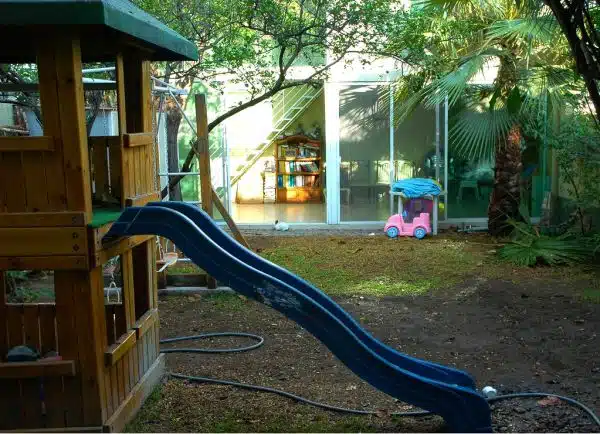

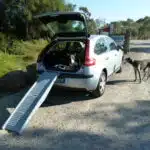
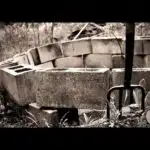

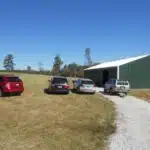
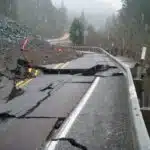
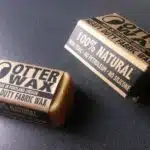

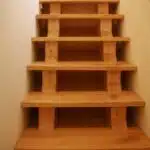

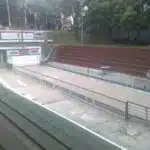







![How To Build A Detached Deck 20 Force Reconnaissance Detachment Deck Shoot [Image 4 of 4]](https://green-life.blog/wp-content/uploads/2023/05/RJo3tlizSGjq-150x150.jpg.webp)




